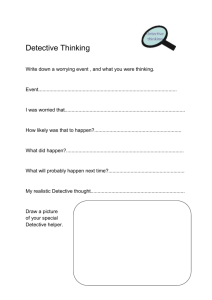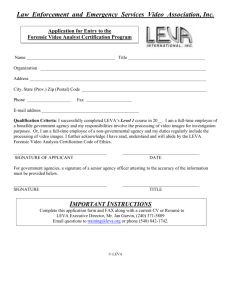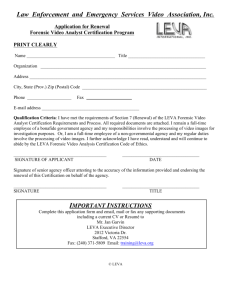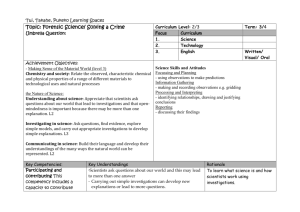2012 - International Association of Chiefs of Police
advertisement
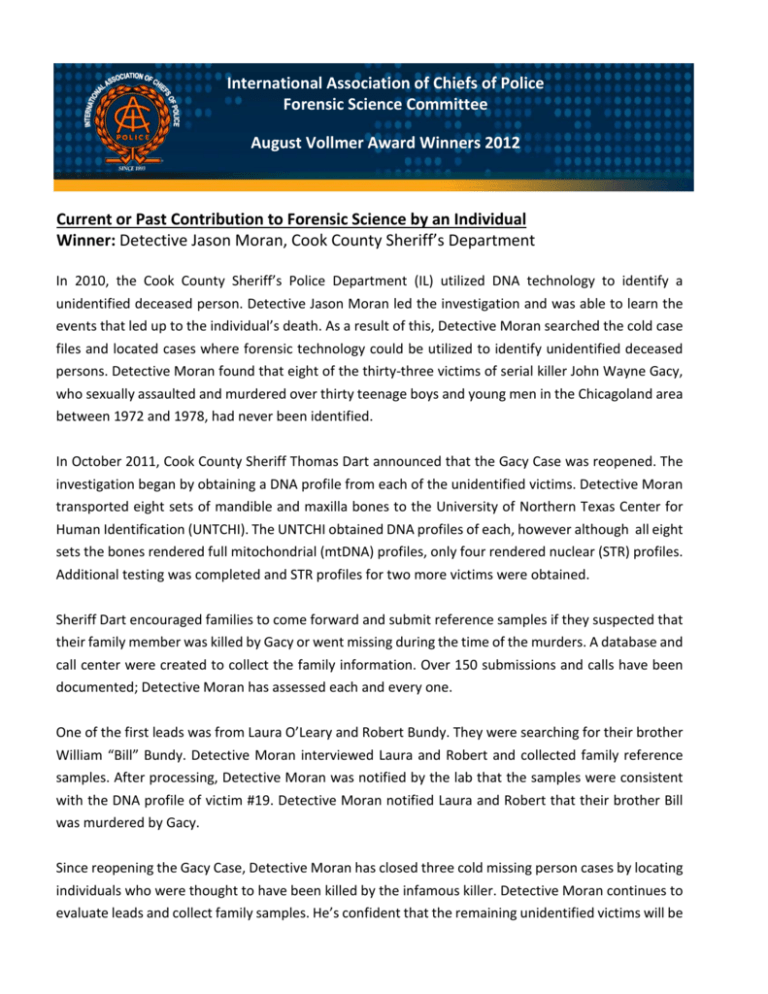
International Association of Chiefs of Police Forensic Science Committee August Vollmer Award Winners 2012 Current or Past Contribution to Forensic Science by an Individual Winner: Detective Jason Moran, Cook County Sheriff’s Department In 2010, the Cook County Sheriff’s Police Department (IL) utilized DNA technology to identify a unidentified deceased person. Detective Jason Moran led the investigation and was able to learn the events that led up to the individual’s death. As a result of this, Detective Moran searched the cold case files and located cases where forensic technology could be utilized to identify unidentified deceased persons. Detective Moran found that eight of the thirty-three victims of serial killer John Wayne Gacy, who sexually assaulted and murdered over thirty teenage boys and young men in the Chicagoland area between 1972 and 1978, had never been identified. In October 2011, Cook County Sheriff Thomas Dart announced that the Gacy Case was reopened. The investigation began by obtaining a DNA profile from each of the unidentified victims. Detective Moran transported eight sets of mandible and maxilla bones to the University of Northern Texas Center for Human Identification (UNTCHI). The UNTCHI obtained DNA profiles of each, however although all eight sets the bones rendered full mitochondrial (mtDNA) profiles, only four rendered nuclear (STR) profiles. Additional testing was completed and STR profiles for two more victims were obtained. Sheriff Dart encouraged families to come forward and submit reference samples if they suspected that their family member was killed by Gacy or went missing during the time of the murders. A database and call center were created to collect the family information. Over 150 submissions and calls have been documented; Detective Moran has assessed each and every one. One of the first leads was from Laura O’Leary and Robert Bundy. They were searching for their brother William “Bill” Bundy. Detective Moran interviewed Laura and Robert and collected family reference samples. After processing, Detective Moran was notified by the lab that the samples were consistent with the DNA profile of victim #19. Detective Moran notified Laura and Robert that their brother Bill was murdered by Gacy. Since reopening the Gacy Case, Detective Moran has closed three cold missing person cases by locating individuals who were thought to have been killed by the infamous killer. Detective Moran continues to evaluate leads and collect family samples. He’s confident that the remaining unidentified victims will be identified. Detective Moran recently organized a training seminar with ViCap, NamUs, and UNTCHI and has completed detailed analysis of Cook County’s burial of indigent, unclaimed, and unidentified deceased person processes. He has found deficiencies that prevent law enforcement from associating missing person’s cases with unidentified deceased person’s cases. Detective Moran has established an investigative template for other law enforcement agencies that can dramatically impact these types of cases in an area that has been neglected for so long. Current or Past Collaboration in Forensic Science Winner: Vancouver Police Department (VPD), Integrated Riot Investigation Team On June 15, 2011, in Vancouver, Canada over 150,000 people took to the streets after the Stanley Cup final game; what followed resulted in the largest Canadian criminal investigation of its type. Rioters destroyed property, looted businesses, started fires, and assaulted those who got in their way. Hundreds engaged in criminal acts while thousands more formed a sea of encouraging spectators, many recording the “action” on their handheld electronic devices. A seventy-member Integrated Riot Investigation Team (IRIT) composed of eight police agencies was formed in the days following. In effect a mid-size police department was created from the ground up; together with vehicles, office space, computers and staffing resources. Over 5,000 hours of video was seized from the public and the media. This amount of video would overwhelm the processing capabilities of any forensic video lab and threatened to overburden the existing VPD infrastructure. Members of IRIT and Law Enforcement and Emergency Services Video Association (LEVA) joined together. Forensic video analysts internationally were called upon to work on the project. The hours of video were converted into one format ensuring investigative integrity. Video was then reviewed using Avid Media Composer to “tag” events and suspects using multiple unique but standardized searchable criteria to provide individualization. This enabled investigators to search for suspects similar to an internet search engine. While IRIT members were at the LEVA Lab, strategic timing saw the VPD infrastructure upgraded with five new Avid work stations installed and three updated. This infrastructure provided investigators with a means to search for a suspect who committed multiple offenses at different locations and to locate video clips and photographs to be used for interviews, disclosure, and website outreach. Currently, IRIT has “tagged” 67,000 unique entries and 15,000 criminal acts. The investigative team has recommended over 400 criminal charges against 150 rioters with projections of charging nearly 300 rioters by the time the investigation concludes. The website has generated over 1.5 million visits and 2|Page an additional 7,633 tips. The IRIT investigative approach has revolutionized how police will deal with modern day investigations of this size. With the innovative and creative steps taken, this extraordinary investigation will result in hundreds of rioters charged and each one held accountable for the crimes they committed. Current or Past Collaboration in Forensic Science Winner: Law Enforcement & Emergency Services Video Association, International (LEVA) In 2006, LEVA opened the Digital Multimedia Evidence Analysis Training Facility (Lab) at the University of Indianapolis and to support of their goals, LEVA formed the Forensic Video Analysis Response Team, a group of serving law enforcement video analysts from throughout the world, who are trained to operate in a collaborative investigative environment. On June 15, 2011, game seven of the Stanley Cup Finals was played in Vancouver, Canada. Shortly after the conclusion of the game, a riot ensured, with the crowd estimated at 150,000 in downtown Vancouver. In response to the riots, the Vancouver Police Department (VPD) and the Integrated Riot Investigation Team (IRIT), requested the assistance of LEVA’s response team to help analyze, and process video evidence collected. With the proliferation of video recording devices, ranging from CCTV systems to consumer camcorders and mobile phones, IRIT investigators collected over 5000 hours of video evidence. It is estimated to be the most recorded criminal event in North America. It became clear to VPD that they lacked the staff and the resources to examine and analyze this amount of visual evidence. The VPD reached out to LEVA with a request to activate its Forensic Video Analysis Response Team and to use the Lab to begin processing the Digital Multimedia Evidence (DME). In September and October of 2011, 37 LEVA analysts, representing 36 agencies from across the U.S., Canada and the United Kingdom, joined 21 IRIT investigators at the Indianapolis Lab. Together they produced a searchable database of suspect images and actions that now drives the on-going investigation in Vancouver. For this case, LEVA developed a unique triage methodology to automate transcoding and to consolidate DME into a shared storage environment powered by Avid Technology’s Media Composer. Analysts effectively utilized the Avid Bin Architecture to develop and populate searchable forensic custom columns during the data-infusion process, which visually links suspects to crimes. IRIT Commanders leveraged the interoperable design of the Avid system, allowing multiple investigators to simultaneously and instantly search through thousands of video clips as they tracked each suspect’s actions and movements. The database currently contains over 65,000 tagged suspect links. 3|Page This unprecedented effort has demonstrated how collaboration among agencies and supportive partners like LEVA, can result in highly successful investigations that are dependent on video evidence. The collaborative approach clearly demonstrates how coordinated and focused efforts to examine, analyze, organize and utilize large amounts of video evidence can help solve major crimes. The creation of a carefully designed database of image evidence has enabled IRIT to successfully manage and utilize an immense amount of video evidence and has provided a roadmap for future large scale investigations. Significant Investigative Value in a Major Crime Winner: Philippine National Police In October 2005, a man was shot and killed in Manila, Philippines. This seemingly random killing began a shooting rampage that lasted over two years, spanning 10 cities and 7 provinces, and leaving 34 wounded and 38 killed. In all, there were a total of 33 incidents and investigators recovered hundreds of pieces of ballistic evidence from the crime scenes. Initially, there was only one firearm involved: a 9mm Glock used in the Cavite shooting. This was the “Alpha Gun.” Later it would be joined by 11 other guns. In December 2005 three incidents occurred within a six-mile radius leaving five people killed. In July 2006, a man walked into a restaurant and shot and killed six people. In March 2008, firefighters arrived at the burning apartment to find the body of model and actress, Scarlet Garcia, along with three others who had all been shot and killed. Investigators got their first break in April 2008 when three men broke into a house and sexually assaulted a woman. The perpetrators then proceeded to the house across the street where they sexually assaulted another woman. Neighbors, roused by the commotion, called the police. Two suspects were arrested and a .45 and a 9mm pistol were recovered. The 9mm was identified as the one used in the Garcia murders. The ‘3K killings’, as the murders came to be known, ended with the arrests of two individuals; to this day they refuse to identify their cohorts. With no other leads available and no witnesses, the 31 other cases went cold. 11 guns were unaccounted for; amongst them the “Alpha Gun,” the one that started it all. In addition to the estimated 1,500,000 licensed firearms, there are an around 300,000 “loose” or undocumented guns in the Philippines. In 2008, the Crime Lab had an inventory of around 120,000 pieces of ballistic evidence. Although the Philippine National Police had hundreds of pieces of evidence from the 3K cases, the method of comparison of ballistics data made it impossible to utilize the vital information. In 2008, PNP implemented a strategy to better address gun crime; they required all new 4|Page firearms be test-fired for future encoding before being sold, and declared a general firearms amnesty wherein all loose firearms could be licensed, no questions asked, with a given period. All guns submitted for amnesty were to be test-fired. In March 2011, the PNP Firearms Identification Division (FAID) began encoding their inventory of ballistic evidence into the newly-acquired Integrated Ballistic Identification System (IBIS). By September 2011, the Crime Evidence Database (CED), had generated 500 confirmed “hits” out of only 15,000 database entries. Encouraged by these results, FAID encoded 3K evidence. Correlating against the CED, IBIS found three more cases involving the 3K guns; bringing the total number of cases to 36, and victims to 91. In December 2011, IBIS flagged a “hit” for a 9mm Glock. A list of all the Glock’s “hits” was generated. There were more than 90 in all—linked to 24 of the 36 cases—it was the “Alpha Gun”. The test-fire that generated the hit was not part of the original 3K evidence set—it came from a registered gun. A check of records led investigators to the owner of the gun that started it all. Police compiled data on the person and known associates, and records have been cross-referenced, to find out if these individuals own firearms and/or have been involved in past crimes. The experience can be viewed as a kind of transformation of forensic science and technologies from a reactive discipline into proactive tools for law enforcement. The projected comprehensive crime and registration ballistic databases in the Philippines will serve both as valuable a investigative tool and deterrent to firearms crime. Innovation in Forensic Technology Winner: The Boston Police Department Automated ballistics imaging and analysis systems, such as the Forensic Technology’s (FT) Integrated Ballistic Identification System (IBIS), have advanced gun law enforcement operations by allowing images of gun crime evidence to be rapidly compared to a large inventory of evidence collected from other crime scenes. Unfortunately, the 2D grayscale digital photography used by the original IBIS equipment was often not refined enough to suggest potential matches between often highly damaged bullets from separate crime scenes. Through the acquisition of three-dimensional measurements, the BulletTrax-3D image acquisition technology improved the ability of law enforcement agencies to make bullet matches through automated ballistic imaging and analysis. The Boston Police Department (BPD) and FT collaborated on an evaluative study to assess the value added by 3D bullet imaging technology to their gun law enforcement operations. BPD acquired and 5|Page tested the IBIS BulletTrax-3D bullet imaging system and IBIS MatchPoint+ a comparative analysis system for 2D and 3D images. A team of Harvard University and Northeastern University researchers, led by Dr. Anthony A. Braga and Dr. Glenn L. Pierce, conducted the formal evaluation. The National Research Council (2008) report suggested that the advancement of 3D ballistic imaging technology could be helpful in improving match rates for crime bullets. The vast majority of ATF’s National Integrated Ballistics Information Network (NIBIN) cold hits linked cartridge casings rather than bullets. The IBIS 2D technology is not very effective in detecting potentially identical markings among bullet images when compared to detecting potentially identical markings among less damaged and distorted cartridge casings recovered from crime scenes. During the study period, the same bullet evidence was entered into the BulletTrax-3D and heritage IBIS 2D systems. BulletTrax-3D system made 9 hits that linked 3 homicide incidents, including a triple homicide, 7 gun assault incidents, 4 illegal gun possession incidents, and one found gun incident. All 9 cold bullet hits were regarded as noteworthy investigative leads and the significance of each lead was determined by the investigative and intelligence information available from the linked gun crimes. The detectives reported that two cold hits were directly associated with new arrests or the issuance of arrest warrants. The results of the research study found that the BulletTrax-3D imaging technology significantly improved the ability of the BPD Ballistic Unit to make cold hit bullet matches. BulletTrax-3D technology was associated with a 13% increase in the capacity of the Ballistic Unit to image submitted crime bullet evidence, and that BulletTrax-3D made 9 cold bullet hits from 587 crime bullet images acquired while the heritage 2D system made zero cold hits. This experience revealed that the enhanced capacity of the BulletTrax-3D imaging technology represents a dramatic improvement over the heritage 2D system in ballistic imaging and analysis. The adoption of this technology nationwide would lead to the increased apprehension of repeat gun criminals. 6|Page
